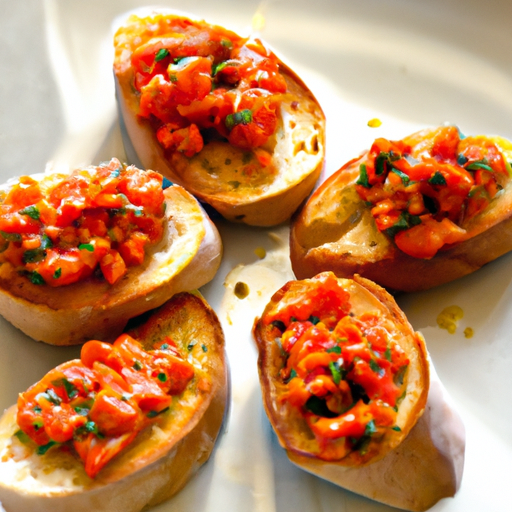The Delicious Delight of Crostini
Crostini is a delightful Italian appetizer that has captured the hearts and taste buds of food enthusiasts all over the world. With its irresistible combination of crunchy bread and delectable toppings, crostini has become a staple in the culinary realm. In this blog post, we’ll delve into the intricacies of crostini and explore its taste, common uses in cooking, nutritional value, and some interesting history and facts.
Taste and Texture
Crostini is all about texture and flavor harmony. It starts with a base of thinly sliced or toasted bread, typically made from a crusty loaf like baguette or ciabatta. The bread is then rubbed with garlic or brushed with olive oil to add even more flavor. The result is a perfect fusion of crispy crunchiness with a hint of garlic and the richness of olive oil.
The true magic of crostini lies in the assortment of toppings that grace its surface. From creamy cheeses and salty cured meats to vibrant vegetables and aromatic herb spreads, the possibilities are endless. Each bite offers a symphony of textures and flavors that dance across your palate, leaving you craving for more.
Versatile Uses in Cooking
Crostini’s versatility in the kitchen is nothing short of remarkable. It can be enjoyed as an appetizer, a light snack, or even as a main course when paired with a hearty salad. The blank canvas of toasted bread allows for endless creativity, making it a go-to choice for any occasion.
One classic crostini variation is topped with bright red tomatoes, fresh basil, and a drizzle of balsamic reduction. The balance of sweet and tangy flavors creates a burst of freshness in every bite. Another popular option involves smearing the bread with creamy goat cheese and adding a dollop of tangy sun-dried tomato pesto for a more robust and savory experience.
For seafood lovers, crostini provides the perfect stage for succulent shrimp or smoked salmon, enhanced with a touch of zesty lemon and a sprinkle of dill. Vegetarian options are also abundant—think roasted red peppers, whipped feta, or velvety avocado with a squeeze of lime.
Nutritional Value
Though crostini is undoubtedly a treat for the taste buds, it’s worth considering its nutritional value. The bread base provides a good source of carbohydrates, offering a steady release of energy. Opting for whole-grain or whole-wheat bread adds an extra dose of fiber and nutrients.
The choice of toppings can significantly impact the nutritional profile of crostini. Lean proteins like grilled chicken or thinly sliced turkey can add a dose of satiating protein, while incorporating a variety of colorful vegetables ensures a range of vitamins and minerals. Choosing heart-healthy fats like olive oil and avocado can also provide essential nutrients and promote overall well-being.
As with any indulgence, moderation is key. Enjoying crostini as part of a balanced diet allows you to relish its flavors while still nourishing your body.
A Brief Historical Insight
Crostini has been a beloved part of Italian cuisine for many centuries. The term “crostino” originates from the Italian word “crosta,” meaning crust. The concept of toasting or crisping bread has been a culinary practice since ancient times when it was commonly used to revive stale bread.
Traditionally, crostini were a great way to utilize day-old bread, reducing waste while creating something delicious. Over time, they evolved into the mouthwatering appetizer we know today. These delectable bites have become synonymous with Italian culture and are often served during family gatherings, celebrations, and even casual get-togethers.
Conclusion
Crostini is a culinary masterpiece that exemplifies the art of simplicity and versatility. Its crispy bread base acts as a canvas for a multitude of flavor combinations, catering to a wide range of palates. From classic tomato and basil to imaginative creations featuring exotic ingredients, crostini is a guaranteed crowd-pleaser.
Whether you’re hosting a dinner party or simply treating yourself to a delightful snack, crostini never disappoints. So next time you’re looking to tantalize your taste buds and impress your guests, consider the irresistible charm of crostini—your palate will thank you!
*Note: Moderation is always key when enjoying any type of food, and individual dietary needs may vary.
Facts about Crostini:
Origin: Crostini is an Italian appetizer that originated in medieval times. The word “crostini” comes from the Italian word “crostino,” meaning “little crust.”
Preparation: Crostini are typically made by thinly slicing a baguette or bread, brushing the slices with olive oil, and toasting or grilling them until they become crisp and golden.
Common uses: Crostini is often served as an appetizer or canape and can be topped with a variety of ingredients. Common toppings include spreads like minced garlic, cheese, cured meats, vegetables, pâtés, and bruschetta toppings like diced tomatoes, basil, and balsamic vinegar.
Nutritional benefits: The nutritional value of crostini depends on the toppings used. The base, which is usually bread, provides carbohydrates, and the toppings can incorporate various proteins, vitamins, and minerals.
Unique properties: One unique feature of crostini is the contrast in texture between the crispy bread exterior and the soft or savory toppings. This combination creates an enjoyable mouthfeel when biting into the crostini.
Historical significance: Crostini were traditionally made using stale bread to avoid wasting food. The toasting process not only prolonged the shelf life of the bread but also made it more palatable.
Variations: While the classic crostini is made with plain bread, there are many variations available today. Some variations include using different types of bread like whole grain, ciabatta, or sourdough. Additionally, creative toppings can make crostini a versatile dish to suit different flavor preferences.
Please note that as an appetizer, the nutritional value and health benefits of crostini can vary greatly depending on the specific ingredients and toppings used.




Use the share button below if you liked it.
It makes me smile, when I see it.